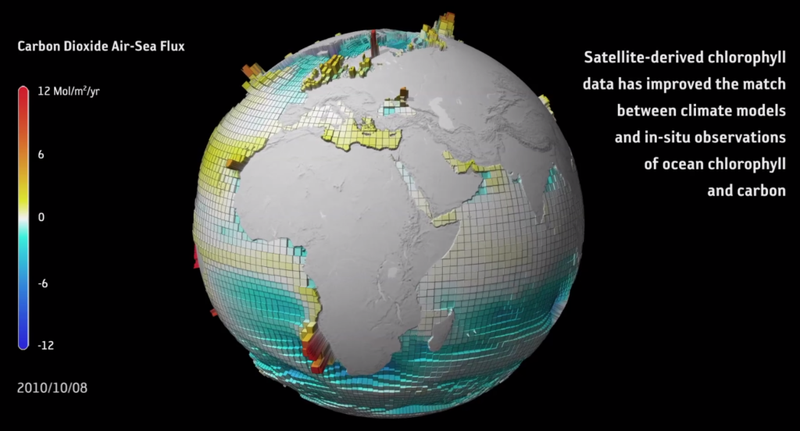Ocean colour animation and assimilation in an ocean climate model
Visualisations of essential climate variables (ECVs) :
- demonstrate the natural variability, seasonality and other climate changes observable in the ESA CCI data;
- are also a way to show the high resolution of the data in both space and time.
Planetary Visions created this particular visualisation for ESA (see below).
The first part of the visualisation shows the changes in ocean colour (OC ECV) caused by changes in phytoplankton in the top layer of the oceans. One of the drivers for phytoplankton growth is the availability of carbon dioxide dissolved in the ocean, which they need for photosynthesis.
The second part shows the exchange of carbon dioxide between the ocean and the atmosphere. The exchange was calculated by assimilating the ocean colour into an ocean climate model which simulates the biochemical and physical properties of the oceans.
Using key Earth observations such as ESA’s CCI ECVs helps climate scientists and other Earth scientists to understand the key Earth system processes, how they operate, and how they are affected by anthropogenic activity, such as carbon dioxide emissions.

About the authors
This article was produced in September 2017 by Shubha Sathyendranath and David Ford.

Shubha Sathyendranath is Head of Remote Sensing and Marine Optics at Plymouth Marine Laboratory and is the Assistant Director for the Partnership for the Observation of the Global Oceans. Shubha leads the OC CCI ECV team. Her research interests include ocean colour modelling, spectral characteristics of light penetration underwater, bio-optical properties of phytoplankton, modelling primary production, bio-geochemical cycles in the sea, climate change, biological-physical interactions in the marine system, ecological provinces in the sea, ecological indicators and phytoplantkon functional types.

David Ford has worked on ocean modelling and data assimilation research at the Met Office since 2008. His main focus is on developing and validating the pre-operational global coupled physical-biogeochemical ocean modelling system. His work covers time scales from near-real-time forecasts to decadal reanalyses, with both operational and climate research applications. David has also worked on shelf seas biogeochemical modelling and validation, and developing error covariances for the data assimilation component of the Met Office’s operational physical ocean forecasting system.

